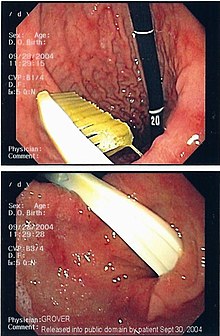Our website is made possible by displaying online advertisements to our visitors.
Please consider supporting us by disabling your ad blocker.
Foreign body in alimentary tract
| Foreign body in alimentary tract | |
|---|---|
 | |
| A foreign body - in this case a swallowed toothbrush - located in the stomach cavity by using an endoscope. | |
| Specialty | Emergency medicine, gastroenterology |
One of the most common locations for a foreign body is the alimentary tract. It is possible for foreign bodies to enter the tract either from the mouth,[1] or from the rectum.[2]
The objects most commonly swallowed by children are coins.[3] Meat impaction, resulting in esophageal food bolus obstruction is more common in adults.[4] Swallowed objects are more likely to lodge in the esophagus or stomach than in the pharynx or duodenum.[5]
- ^ "Pediatrics, Foreign Body Ingestion: Overview - eMedicine". Retrieved 2008-12-18.
- ^ Koornstra JJ, Weersma RK (July 2008). "Management of rectal foreign bodies: description of a new technique and clinical practice guidelines". World J. Gastroenterol. 14 (27): 4403–6. doi:10.3748/wjg.14.4403. PMC 2731197. PMID 18666334.
- ^ Arana A, Hauser B, Hachimi-Idrissi S, Vandenplas Y (August 2001). "Management of ingested foreign bodies in childhood and review of the literature". Eur. J. Pediatr. 160 (8): 468–72. doi:10.1007/s004310100788. PMID 11548183. S2CID 7550183. Archived from the original on 2001-11-22. Retrieved 2008-12-18.
- ^ Conway WC, Sugawa C, Ono H, Lucas CE (March 2007). "Upper GI foreign body: an adult urban emergency hospital experience". Surg Endosc. 21 (3): 455–60. doi:10.1007/s00464-006-9004-z. PMID 17131048. S2CID 30134627.
- ^ Li ZS, Sun ZX, Zou DW, Xu GM, Wu RP, Liao Z (October 2006). "Endoscopic management of foreign bodies in the upper-GI tract: experience with 1088 cases in China". Gastrointest. Endosc. 64 (4): 485–92. doi:10.1016/j.gie.2006.01.059. PMID 16996336.
Previous Page Next Page


